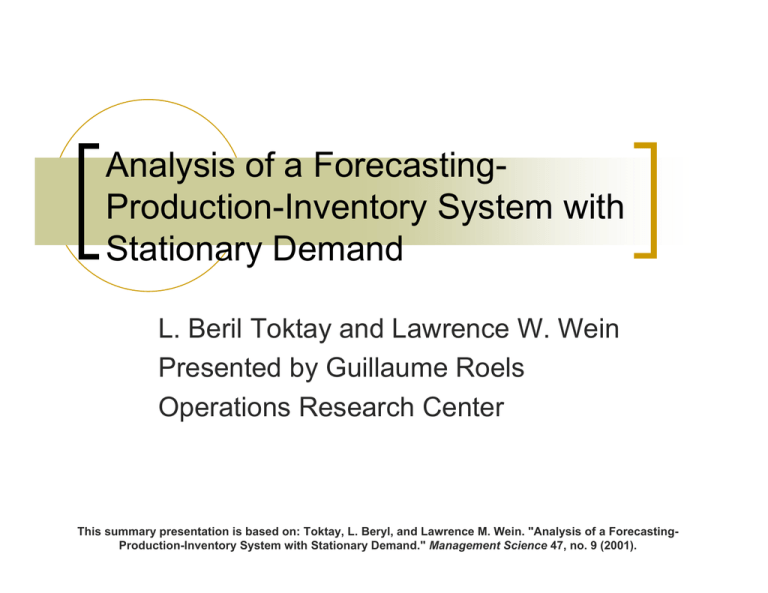Analysis of a Forecasting- Production-Inventory System with Stationary Demand
advertisement

Analysis of a ForecastingProduction-Inventory System with
Stationary Demand
L. Beril Toktay and Lawrence W. Wein
Presented by Guillaume Roels
Operations Research Center
This summary presentation is based on: Toktay, L. Beryl, and Lawrence M. Wein. "Analysis of a ForecastingProduction-Inventory System with Stationary Demand." Management Science 47, no. 9 (2001).
Forecasting-ProductionInventory
Demand
forecast
update
Make-to-Stock environment
Ct ~ N ( µ , σ )
2
C
Rt
Order
release
Dt
It
Qt −1
Pt = min{Qt −1 , Ct }
Objective
Minimize steady-state
{
{
Inventory holding costs h
Shortage penalty costs b
Recap: MMFE Model
Rolling horizon H
Forecast Dt ,t +i i = 0,… , H
Forecast Update
ε t ,t +i = Dt ,t +i − Dt −1,t +i
Assumptions
{
{
{
Stationary Demand with rate λ
Unbiased Forecasts
Uncorrelated Forecast Updates
Production-Inventory Model
MRP-Type Release Policy:
H −1
Rt = ∑ ε t ,t +i + Dt ,t + H = eT ε t + λ
i =0
Inventory Policy
H
Qt + I t − ∑ Dt ,t +i = sH
i =1
It
Production Policy
Forecast-corrected base-stock policy
⎧⎪Ct
if sH > I t −1 + Ct ⎫⎪
P ( I t −1 ) = ⎨
⎬
⎩⎪ sH − I t −1 if sH ≤ I t −1 + Ct ⎭⎪
*
State-dependent Optimal Policy
( Dt −1,t , Dt −1,t +1 ,… , Dt −1,t + H −1 , λ )
Benchmark: Myopic Policy
Do not use available forecast
information
Rt = Dt
Constant Inventory
Qt + I t = sm
Outline
Model
Steady-State Distribution of WIP
Base-Stock Levels
Discussion
Conclusion
In Heavy Traffic, the WIP has
an exponential distribution
Average Excess Capacity
2( µ − λ )
v= T
2
e Σe + σ C
Variance of the forecasts
Variance of the production
WIP at time n
units
n
X n = ∑ ( Rt − Ct )
t =1
Qn = X n − inf1≥t ≥ n X t
R2 − C2
time
Heavy traffic analysis 1
Consider a sequence of systems k s.t.:
k (λ
(k )
λ
(k )
→λ
µ
(k )
→µ
−µ )→c<0
(k )
Heavy traffic analysis 2
(k )
n
Q
k
X
(k )
⎢⎣ kt ⎥⎦
=
=
X
X
(k )
n
k
(k )
⎢⎣ kt ⎥⎦
+
−m
− inf1≥t ≥ n X
(k )
t
k
(k )
⎣⎢ kt ⎦⎥
k
k
(k )
(k )
(k )
where m = λ − µ
+
m
(k )
⎢⎣ kt ⎥⎦
k
Heavy traffic analysis 2
σ B(t )
X
(k )
⎢⎣ kt ⎥⎦
k
=
BM (c, σ )
2
X
(k )
⎢⎣ kt ⎥⎦
−m
(k )
k
ct
⎢⎣ kt ⎥⎦
+
m
(k )
⎢⎣ kt ⎥⎦
k
Heavy traffic analysis 3
(k )
n
Q
k
=
X
(k )
n
k
+
− inf1≥t ≥ n X
k
RBM (c, σ 2 )
Reflected Brownian Motion
on the nonnegative halfline
Estimated by an exponential
random variable
(k )
t
Steady-state WIP distribution
P(Q∞ = 0) = 1 − e
P(Q∞ > x) = e
− vx
− vβ
impulse
(x + β )
β is a correction term, coming from
Random Walks
Outline
Model
Steady-State Distribution of WIP
Base-Stock Levels
Discussion
Conclusion
Determination of the BaseStock levels 1
Myopic Policy
⎛ b ⎞
sm = F ⎜
⎟
⎝b+h⎠
−1
Q∞
Newsboy quantity…
… considering the distr. of the WIP!
1 ⎛ b⎞
sm = ln ⎜1 + ⎟ − β
v ⎝ h⎠
Determination of the BaseStock levels 2
MRP-type Policy
⎛ b ⎞
sH = F ⎜
⎟
⎝b+h⎠
−1
W
W = max{Q∞ + Y0 , max1≤ k ≤ H Yk }
Y0 is the difference between:
{
{
Total Forecast Error over the horizon H and
Total Capacity
Determination of the BaseStock levels 3
MRP-type policy: asymptotic
b
h
⎛1⎞ 2
s = s + µY 0 + ⎜ ⎟ σ Y0 v
⎝2⎠
Proportional to the variance!
Good approximation when
{ b / h large
a
H
{
*
m
High utilization rate
Outline
Model
Steady-State Distribution of WIP
Base-Stock Levels
Discussion
Conclusion
Capacity – Stock Trade-Off
No advance information
s = s − Hλ
a
H
*
m
Full advance information
Interchangeability Capacity/Safety Stock
Demand variability
Capacity
2
⎛
⎞
σ
*
a
D
s H = sm − H λ − H ( µ − λ ) ⎜ 2
2 ⎟
⎝ σ D +σC ⎠
Discussion
*
↑→
v
↓→
s
Correlation
m ↑
σ Y20 is the system variability over H not
resolved at the beginning of the horizon
{
Preference for accurate early forecasts
Optimize over all planning
horizons
H −1
Rt =
Greater costs due to
{
{
∑ε
i=0
t , t +1
+ Dt , t + H
misspecification of the forecast model than
misuse of the information in production
Outline
Model
Steady-State Distribution of WIP
Base-Stock Levels
Discussion
Conclusion
Conclusion
Integrated view
{
{
{
Forecast
Production
Inventory
Lots of improvement for current MRP
systems
Is heavy traffic of practical value?
Thank you
Questions?




